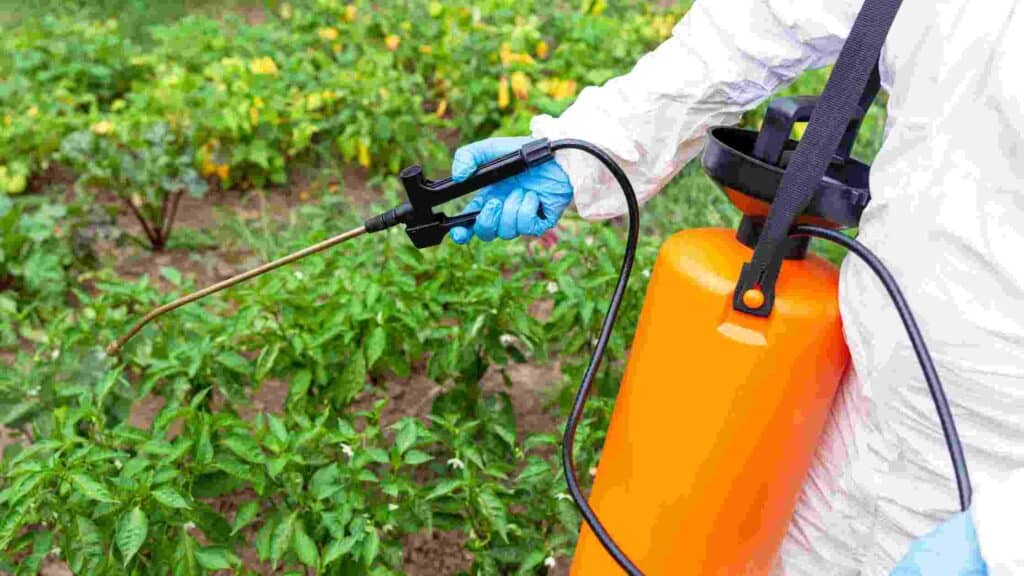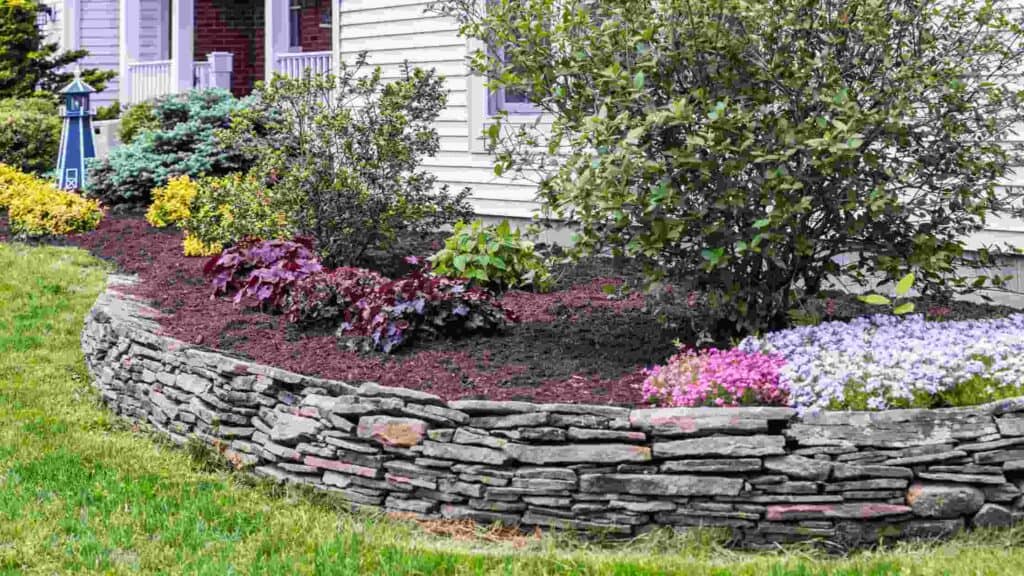In this guide, we’ll explore effective methods for how to fix a lawn full of weeds and reclaim your outdoor space.
If you’re facing the unfortunate situation of having your once-green lawn overrun by weeds, don’t worry – there’s hope.
Restoring your lawn to its lush, healthy state may not be a walk in the park, but with the right approach and some grass seed, you can make it happen.
How To Fix A Lawn Full Of Weeds
While your first thought might be to grab a bottle of commercial weed killer, there are alternative approaches to tackling a lawn full of weeds.
Chemical solutions can be harsh on the grass, damage the garden, and pose risks to pets, wildlife, and children who play on the lawn (learn how to kill grass and weeds).
Identifying Types Of Weeds In Lawn
Weeds in lawns generally fall into two main categories: Grass and Broadleaf types. One familiar Broadleaf weed is the Dandelion (check out: can you eat dandelions from your yard?).
When it comes to gardening, these seemingly harmless plants are a true nuisance. Dandelions can quickly turn your lawn into a breeding ground for more weeds, spreading several seeds across the grass. So, dealing with them promptly is crucial (here are the best dandelion killers).
Using Herbicide For Lawn

When faced with a garden infested with weeds, one option is to turn to chemical solutions for weed control. However, it’s essential to exercise caution to avoid harming the healthy grass, other plants, or wildlife in the process.
Opt for a chemical weed killer that doesn’t turn foliage yellow-brown, as this type tends to penetrate deep into the core of the weed, effectively killing it from within.
How To Get Rid Of A Lawn Full Of Weeds Naturally
Consider trying natural remedies that can be just as effective without the harmful side effects. For instance, regular kitchen vinegar can be a potent weed killer for lawns.
Various types of vinegar, such as apple cider, distilled, or white vinegar, can work well. The results are noticeable within an hour after application, whereas chemical herbicides can take longer to take action.
Using Vinegar To Eliminate Weeds
- Select vinegar having a high acidity ratio, ideally around 5% for optimal effectiveness.
- Fill a spray bottle or watering can with water, adding the vinegar in the appropriate amount.
- Optionally, mix in some dishwashing agent to the solution, as it helps break down the plant structure.
- Another optional addition is salt, which prevents weed regrowth. However, be cautious, as salt inhibits all plant growth, not just weeds. Make sure you don’t plan on planting anything soon in the treated area (read more about it: does Epsom salt kill weeds?)
Other Ways For How To Fix A Weedy Lawn Without Chemicals
Besides vinegar, there are other natural alternatives that you can try to combat weed invasion, including boiling water, alcohol, and soap.
When To Start A New Lawn
In some cases, a lawn overwhelmed with weeds might be too far gone for simple repairs.
To determine whether starting your lawn from scratch is the better option, assess the extent of weed coverage in your garden. If over 50% of the area is taken over by weeds, it might be easier and more practical to reset the entire lawn.
How To Start A New Lawn And Prevent Weeds
To begin anew, apply a weed killer about 3 weeks prior to embarking on the lawn renovation project.
Once the existing lawn has died off, it’s time to aerate the soil. This task can be time-consuming, so it’s advisable to consider renting an Aerator from a local hardware store (find out the best lawn aerator machine).
An aerator is a useful tool creating small holes across the area as you move it along. It helps loosen the soil, preparing it for the new grass seeds. Adequately refreshing the lawn takes 8 to 10 passes to ensure the soil is thoroughly prepared.
For smaller lawns, a garden fork or a manual aerator can be used, but keep in mind that it can be physically demanding.
If you have arthritis, a bad back, or experience sore knees, opting for a motorized aerator is a smarter choice. Alternatively, enlisting the help of a friend can make the task more manageable.
Once the lawn is aerated, spread the grass seeds evenly using a seed distributor. To prevent wind from disturbing the seeds and undoing your efforts, gently rake over the area.
Remember to fertilize the newly planted lawn to encourage healthier and faster grass growth.
Water the area two times daily unless there’s sufficient rainfall. Within approximately two weeks, you should start seeing healthy, fresh grass sprouting.
Maintaining The New Weed-Free Lawn

Once you’ve successfully transformed your lawn into a weed-free haven, the key to its long-term beauty lies in consistent maintenance.
By adopting proper lawn care practices, you can prevent those pesky weeds from making a comeback and preserve the lushness of your green space.
You may also be interested in finding out what to put under rocks to prevent weeds.
Tips For Weed Control
Follow these practical tips to effectively keep weeds under control:
- Regular Garden Inspections: Make it a habit to monitor the garden every day for any new weed intrusions. Addressing them early prevents them from spreading and causing further trouble.
- Remove Weeds Promptly: When you spot weeds, tackle them immediately, especially when they are young as they are easier to handle.
- Thoroughly Remove Weeds: When weeding, be sure to get rid of as much of the weed as possible, right down to its roots. Weeds can regrow from even the tiniest remnants (check out how to kill thistle weeds).
- Dispose of Weeds Properly: When removing weeds, avoid leaving them on the soil or grass, as they may contain seeds that can lead to new weed growth.
- Regular Mowing: Keep your lawn well-maintained by mowing it regularly. By doing so, you prevent weeds from gaining the upper hand and spreading their seeds.
- Timing Matters: Weeding after rainfall can be beneficial, as the soil is softer, making it easier to remove weeds from their roots. Additionally, sprinkling salt in difficult-to-reach areas like holes in the concrete pathway can help control unwanted growth.
Choosing Quality Mulch
An essential step in maintaining your new lawn is using high-quality mulch from a reputable source. Mulch serves as a protective barrier, preventing weeds sprouts, and roots (learn what is mulch all about).
However, ensure that the mulch you use is free from weed seeds to avoid reintroducing the very problem you worked so hard to eliminate (here’s how to keep weeds out of mulch).
FAQs – How To Fix Lawn With Weeds
1. How do I permanently stop weeds from growing in my lawn?
To permanently stop weeds in your lawn, maintain a healthy, thick turf through proper watering, mowing, fertilizing, and overseeding, and use selective herbicides as needed
2. Should I pull all the weeds out of my lawn?
Pulling weeds from your lawn can be helpful, but addressing the underlying issues that promote weed growth is crucial for long-term control.
3. What causes weeds to take over a lawn?
Weeds can take over a lawn due to factors like poor soil health, inadequate mowing or watering, thin grass coverage, and lack of proper maintenance.
4. What happens when my lawn is full of weeds and dead grass?
When your lawn is full of weeds and dead grass, it indicates poor lawn health and requires rejuvenation through proper lawn care practices and weed control.
5. What is the best product to kill weeds and grow grass?
A selective herbicide designed for your specific lawn type and weed type can effectively kill weeds while promoting grass growth (here is the best weed killer for lawns).
6. What is the best way to get rid of a yard full of weeds?
To get rid of a yard full of weeds, start by addressing soil and lawn health, consider using herbicides, and overseed to encourage grass growth.
Check out our top pick for the best corded electric weed eater.
7. Will grass fill in after killing weeds?
After killing weeds, the grass can fill in the bare areas if you maintain a healthy lawn through proper care and regular overseeding.
Conclusion: How To Fix A Yard Full Of Weeds
In regards to achieving a weed-free lawn, it’s crucial to prioritize general lawn care, whether through natural or chemical weed killers or manual weed removal.
The key lies in maintaining a thick, well-maintained lawn, which acts as a formidable defense against weed invasion.
By following these maintenance tips diligently, you can enjoy a beautiful, weed-free lawn for years to come.
